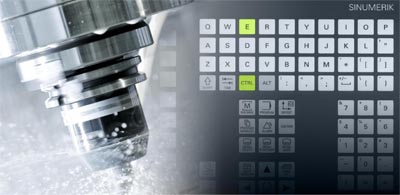
The topic of energy savings is increasingly gaining importance in the machine tool industry because of the rising cost of energy, ever more stringent environmental regulations and efforts to obtain certification according to the international energy efficiency standard EN16001. According to a recent EU Commission report, industrial production accounted for 40 percent of total power consumption in the EU-27 in 2007, of which 70 percent was used by electrical drive systems. Depending on the company involved, machine tools can account for up to 68 percent of the total energy requirement. This fact makes energy efficiency in manufacturing a decisive factor in reducing plant costs and improving overall competitiveness. With this in mind, Siemens has carried out an energy analysis of individual machine tool components with the goal of achieving significant cuts in energy consumption through Sinumerik Ctrl-Energy.
With Sinumerik Ctrl-Energy, Siemens has opened up a broad range of solutions for the energy-efficient operation of machine tools, encompassing its Sinamics drive systems and motors, CNC and drive functions, PC software solutions and services. Sinumerik Ctrl-Energy offers energy-efficient solutions covering every aspect of the machine's lifecycle, starting from machine design and engineering through machine operation and partial or complete retrofit. This makes Sinumerik Ctrl-Energy a broad-based platform for efficient machine management, which will benefit both the machine tool OEM and end-user.
Using a simple ‘Ctrl' and ‘E' key combination on the operator panel, Sinumerik CNCs can provide a fast evaluation of the machine tool's energy consumption and also manage energy consumption during machine downtime. Using the ‘Ctrl-E Analysis' function, Sinumerik controls determine both the energy consumption of a drive system and the entire machine. They enable the user to analyze the amount of energy that goes into machining every individual workpiece as the basis for machining strategy improvements. The ‘Ctrl-E Profiles' function also provides a configuration platform for the management of the machine's energy saving modes, helping to selectively shut down specific power loads during downtimes.
The Siemens Sinamics S120 drive system permits dynamic energy management in the DC link and makes use of a highly efficient power recovery system, which initially stores generated braking energy in a DC link and optionally feeds it back into the grid rather than allowing the brake resistance to turn it into heat. Sinamics drives and Siemens motors have been designed with a clear focus on energy efficiency aspects. In this manner, integrated drive modules from Siemens reach a high efficiency rating of 97–99 percent.
With an efficiency of up to 94 percent in synchronous motors and up to 91 percent in asynchronous motors, the Siemens motor range also provides a basis for energy-efficient machine designs. In a typical machine tool, auxiliary assemblies such as hydraulic supply systems or cooling and lubrication units account for over half the total energy consumption. Energy-saving 1LE standard asynchronous motors have an efficiency rating of up to 97 percent and offer significant potential for auxiliary assembly improvement. The use of Sinamics G120 frequency converters helps adjust the speed and also the energy consumption of auxiliary systems to the level required at each stage of the process.
Sinamics S120 drive systems permit automatic current flow reduction in asynchronous spindles operating under part-load, avoiding unnecessary heat loss. The reactive power of a machine can be fully compensated using the smart infeed and feedback modules of Sinamics S120 drives, rendering costly and loss-prone reactive power compensation units on the end user's premises superfluous.
Control cabinets, along with the required dissipation of heat, have a significant impact on the energy balance of a machine. Siemens can supply machine tool builders with a complete control cabinet that is designed with optimum energy management in mind. Various cooling options exist, including cold plate and direct fluid cooling, which reduce the need for air-conditioning in the control cabinet and make waste heat produced by the drive systems available elsewhere in the form of process heat.
Sizer is the Siemens software tool used to configure energy-efficient drives. It calculates energy consumption and losses incurred with the anticipated load cycles (ramp-up, idle running, running under load, braking, cycle times etc.), as well as the influence of regenerative feedback. This allows the energy efficiency of alternative motor/converter combinations to be evaluated. Using this information, configuration of the feed and main spindle axes can be optimized in line with the process and the anticipated cyclical work flows. Sizer also helps users to avoid over-dimensioning, also in terms of infeed, and to minimize energy consumption.
Contact Details
Related Glossary Terms
- computer numerical control ( CNC)
computer numerical control ( CNC)
Microprocessor-based controller dedicated to a machine tool that permits the creation or modification of parts. Programmed numerical control activates the machine’s servos and spindle drives and controls the various machining operations. See DNC, direct numerical control; NC, numerical control.
- feed
feed
Rate of change of position of the tool as a whole, relative to the workpiece while cutting.
- recovery
recovery
Reduction or removal of workhardening effects, without motion of large-angle grain boundaries.







